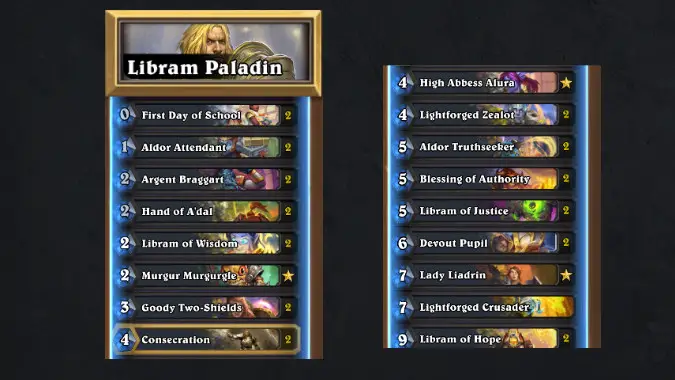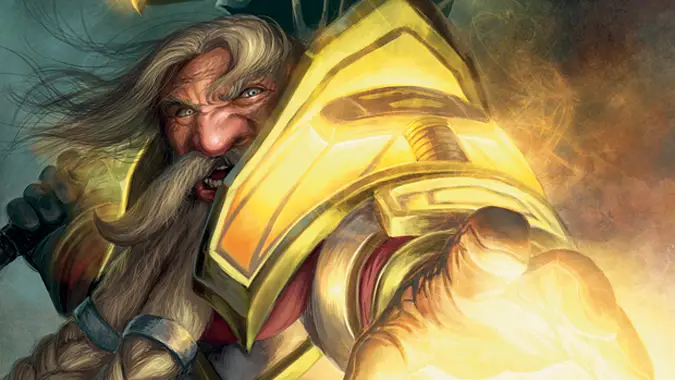How to win in Hearthstone using a Libram Paladin deck

It’s been almost three weeks since the latest Hearthstone expansion, Scholomance Academy, was released. At this point, we can already pinpoint what is good — and what isn’t — with some degree of safety. And thankfully (for me), Libram Paladin, which was already a strong deck before the expansion, has only gotten better — so much that many are placing it in the top tier of the current meta.
Are you interested in fighting for the board without being overly defensive? Do you enjoy gaining control of the battlefield, and then buffing your minions so that they can finish off your opponent? If your answer to those questions is yes, then hang tight, because the Libram Paladin train is about to leave the station!
Let’s take a look at what makes up a Libram Paladin deck and how to play it.

What is the basic strategy to win with a Libram Paladin deck?
First, let’s take a look at which cards are in the deck, so that you’ll know whether you can already build it or if it’s worth crafting based on what your collection looks like. Here’s the deck code:
AAECAZ8FBJuuA/y4A4TBA8PRAw3cA5yuA8q4A/24A+q5A+u5A+y5A8rBA57NA7/RA8DRA8rRA+DRAwA=
- Total Cost: 8,920 dust
- Legendaries: Murgur Murgurgle, High Abbess Alura, Lady Liadrin
Before Scholomance Academy, this deck was far more defensive, and had very high amounts of healing. The current version trades some of that healing potential for more buffs — since the Paladin class got so many good buff cards ever since our beloved headmaster Kel’Thuzad re-opened his school.
When you’re playing, one of the most important parts of the game is the mulligan. And there are a few cards you want to watch for in your opening hand.
Cards to consider keeping in your mulligan:
- Aldor Attendant — this is of utmost importance, since you want to reduce the cost of your Librams as soon as you can. And it comes with a 1/3 body to boot, which is nothing to scoff at during the early turns — especially since you can so easily buff it.
- First Day of School — amazing new card. The number of powerful random 1-drops you can find with this is shockingly high. If you have both Aldor Attendant and First Day of School in your opening hand, you will still want to cast the Aldor Attendant first — usually — but you might find yourself a neat surprise from the random minions. That said, also consider saving this to activate some Spellburst effect if you’re already holding one (there are three of them among your 40 cards).
- Hand of A’dal — helps you control the board in the early game and draws you a card. Drawing cards is nearly always a very good thing — and even more so on a class such as Paladin, which has so few drawing options.
- Murgur Murgurgle — this little guy’s Divine Shield allows it to trade positively in most cases — that is, it’ll likely survive until your next turn, allowing you to pick who it trades against, giving you the possibility of using it to kill (or finish off) some stronger minion. And you want it to be placed down and sacrificed as soon as possible, to give you a higher chance to draw Murgurgle Prime later on.
- Goody Two-Shields — another strong new card that will allow you to fight for the board. Forgo the temptation to buff it as soon as you place it down, or you’ll be wasting the second Divine Shield.
- Aldor Truthseeker — this costs five mana, but that doesn’t really matter. It’s a very solid body to allow you to contain early to midgame aggression, and it reduces the cost of your Librams by two, which means that you want to place it down as soon as you can, no matter the matchup. It’s a key condition for your deck, regardless of the opponent.
- Lightforged Zealot — not as crucial as every other card listed above, but still solid enough to be considered, since it gives you the chance to hit something for four damage immediately when you play it. Four damage in the beginning of the game is a very big deal, and potentially a game-winning tempo swing in your favor.

How to adapt Libram Paladin decks to different opponents
Strategy is the ability to think not only about the best possible plays for your current turn, but also the next several turns. In other words: It’s planning how you’ll win the game and how you’ll prevent your opponent from winning the game. As such, strategical thinking depends not only on knowing your deck, but also on knowing what your opponent plans to do against you.
Remember that what may look like an optimal play right now may turn out to be a decision that leads you to defeat in the long run. So, let’s analyze the tools this deck provides you with for dealing with different types of opponents.
How to play against aggressive decks
Take it easy. Resist the urge to be too aggressive. You are a midrange deck, so you don’t want to compete with them in a race to see who kills the opponent first. Classes like Hunter and Demon Hunter have many more tools than you for that end.
Save up on your taunts — it might be worth it to try to mulligan not only for Aldor Truthseeker, but for Devout Pupil as well. Lightforged Zealot is of great importance here, too: It will help you heal yourself (to some extent) and let you use your weapon to clear some of the minions, if you can afford to take the damage. Early game buffs, combined with Devout Pupil, are a huge help as well.
Libram of Hope is, no pun intended, your greatest hope to achieve victory. The enormous heal combined with the 8/8 Divine Shield with Taunt will almost always buy you some precious breathing room against your opponent’s aggression.
You want to outlast them: Make them run out of ways to damage you; make them “waste damage” on your minions instead of your face. For that end, it might be worth it to use a Blessing of Authority defensively, on any minion you have or even the 1/1 token from your hero power, just so that you create a threat that they might want to eliminate.
How to play against control decks
Your main way to clear enemy boards is the combo of Libram of Justice and Consecration. For as much as nine mana — or as little as four mana, depending on how much cost reduction you’ve been able to earn for your Librams — you will clear nearly any opposition, no matter how huge it is.
If you suspect that your opponent will having strong boards with huge taunts — like a Druid, a Warrior, or a Priest might do — you will want to mulligan for that combo, or at least for one of the two pieces that compose it. Keep that safe in your hand, and resist the urge to use it unless you really have no other good option. The more you can delay using this combo, the more impact it will likely have in your favor.
It’s not as important to save Libram of Hope to heal yourself when playing against a control deck. You might want to use it to heal a strong taunt, for instance.
You will want to be far more aggressive here than when you’re fighting against an aggressive opponent. Try to save some of your damage for your opponent’s face instead of their minions whenever you can afford to. You don’t want to clear everything they put in your way — just enough to ensure that you’re the one commanding the actions of that game, while chipping away at their health at every opportunity.

Other general tips for your Libram Paladin deck
Paladin has never been about card draw — in fact, that is probably the biggest weakness of the class, especially since Divine Favor got sent into the hall of shame fame. But this deck has the potential to allow you to conjure random cards out of thin air with your Lightforged Crusader and to recycle your buffs with Lady Liadrin. Knowing when to use them is crucial.
- For Lightforged Crusader, you’ll want to empty your hand first, so that you have enough room to create five cards; and also, a way to ensure that you will not end your turn with ten cards in hand, and end up burning one on your next turn. When you play this card, one of these two conditions must be true: Either your hand is so empty that you will not reach ten cards in hand, or you have some leftover mana to cast any card that costs one or two mana.
- For Lady Liadrin, this tip is sort of obvious, but it bears stating anyway: You will only want to play her once you have already cast a resonable amount of buffs earlier in the match. Keep in mind that Libram of Hope also counts as a card that she might bring back to you, and getting extra copies of that card can be a game-winning move.
Libram of Wisdom, once discounted to cost zero mana, is your main way to control the board. Remember that you can cast it on a minion, sacrifice that minion, and then — as it returns to your hand — cast it again on a different minion, repeating as many times as necessary. Each Libram of Wisdom in your hand counts as one extra damage for every minion you have on your board, effectively. Practice with this. Knowing how to recycle this same buff several times in the same turn is a key skill to master when playing Libram Paladin.
Argent Braggart is a ridiculous card. Whenever you play a Libram of Hope or a Blessing of Authority — in other words, whenever you have a big minion on your board — you’ll want to follow it up with this guy, and you’ll net yourself a huge threat for only two mana. But remember that it can also be played right after your opponent places down a big minion.
- Another not-so-obvious feature of this card is that it can copy the attack from a minion and the health from a different minion. So if there’s a 9/1 and a 1/9 on the board when you play it, it will become a 9/9.
Blessing of Authority will often be your main game closer. It is very versatile: besides the defensive use we’ve already talked about, you can use it offensively to clear some enormous minion in your way, or you can attack your opponent’s face with any random minion, no matter how small, and then give them that sweet +8/+8 before ending your turn. In the vast majority of cases, your opponent will be forced to deal with it in some way, which can gain you some precious tempo.
That’s it! Hopefully these tips will help you find success with this deck, which is my favorite deck to play in Hearthstone at the moment — and finally strong enough to allow you to climb the ladder at most levels. Have fun!
Please consider supporting our Patreon!
Join the Discussion
Blizzard Watch is a safe space for all readers. By leaving comments on this site you agree to follow our commenting and community guidelines.
 @harmonicstrike
@harmonicstrike




